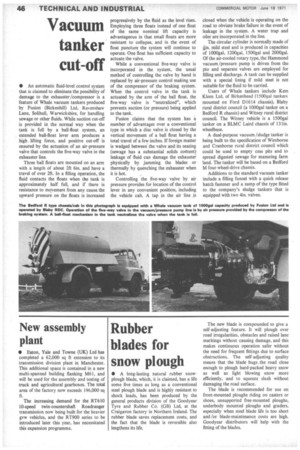Vacuum tanker cut-off
Page 48

If you've noticed an error in this article please click here to report it so we can fix it.
• An automatic fluid-level control system that is claimed to eliminate the possibility of damage to the exhauster /compressor is a feature of Whale vacuum tankers produced by Fusion (Bickenhill) Ltd, Ravenshaw Lane, Solihull, Warwickshire, for handling sewage or other fluids. While suction cut-off is provided in the normal way when the tank is full by a ball-float system, an extended ball-float lever arm produces a high lifting force, and positive cut-off is ensured by the actuation of an air-pressure valve that controls the five-way valve in the exhauster line.
Three ball floats are mounted on an arm with a length of about 2ft 6in. and have a travel of over 2ft. In a filling operation, the fluid contacts the floats when the tank is approximately half full, and if there is resistance to movement from any cause the upward pressure on the floats is increased progressively by the fluid as the level rises. Employing three floats instead of one float of the same nominal lift capacity is advantageous in that small floats are more resistant to collapse, and in the event of float puncture the system will continue to operate. One float has sufficient capacity to actuate the valve.
While a conventional five-way valve is incorporated in the system, the usual method of controlling the valve by hand is replaced by air-pressure control making use of the compressor of the braking system. When the control valve in the tank is actuated by the arm of the bail float, the five-way valve is "neutralized", which prevents suction (or pressure) being applied to the tank.
Fusion claims that the system has a number of advantages over a conventional type in which a disc valve is closed by the vertical movement of a ball float having a total travel of a few inches. If foreign matter is wedged between the valve and its seating (sewage has a substantial solids content) leakage of fluid can damage the exhauster physically by jamming the Hades or thermally by quenching the exhauster when it is hot.
Controlling the five-way valve by air pressure provides for location of the control lever in any convenient position, including the vehicle cab. A tap in the air line is closed when the vehicle is operating on the road to obviate brake failure in the event of leakage in the system. A water trap and oiler are incorporated in the line.
The circular cylinder is normally made of din. mild steel and is produced in capacities of 1000gal, 1200gal, 1500ga1 and 2000gal. Of the air-cooled rotary type, the Hammond vacuum/pressure pump is driven from the pto and separate valves are employed for filling and discharge. A tank can be supplied with a special lining if mild steel is not suitable for the fluid to be carried.
Users of Whale tankers include Kern Kleen Ltd, of Birkenhead (1500gal tankers mounted on Ford D1614 chassis), Blaby rural district council (a 1000gal tanker on a Bedford R chassis) and Witney rural district council. The Witney vehicle is a 1500gal tanker on a BLMC Laird chassis of 131in. wheelbase.
A dual-purpose vacuum /sludge tanker is being built to the specification of Wimborne and Cranborne rural district council which could be used to empty cess pits and to spread digested sewage for manuring farm land. The tanker will be based on a Bedford M four-wheel-drive chassis.
Additions to the standard vacuum tanker include a filling funnel with a quick release hatch fastener and a sump of the type fitted to the company's sludge tankers that is equipped with two 4in. valves.
































































































































